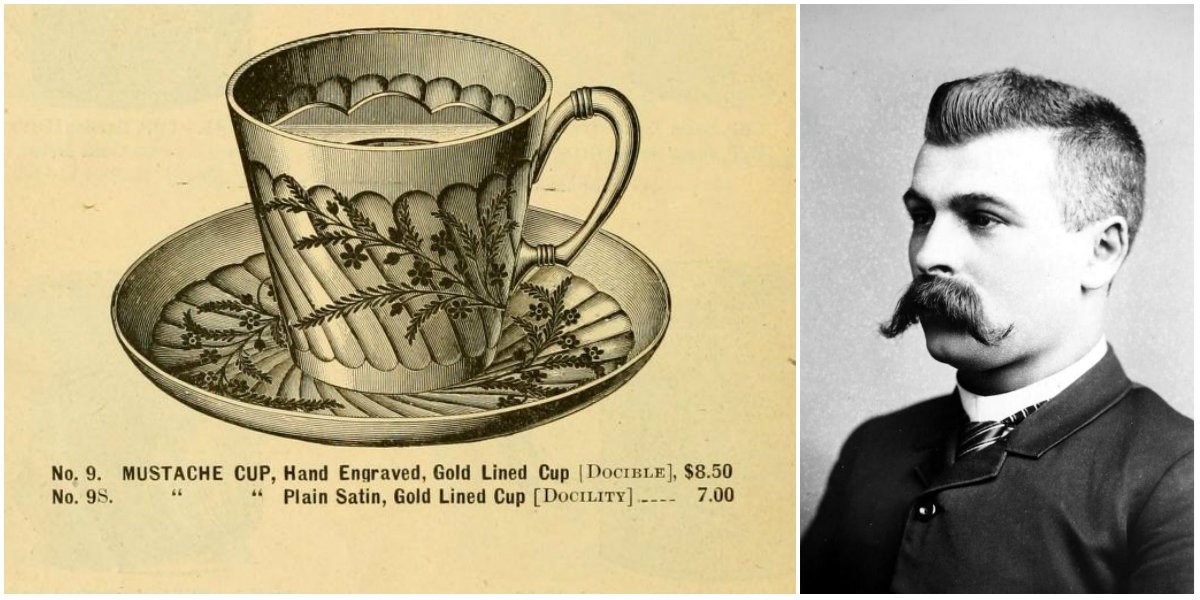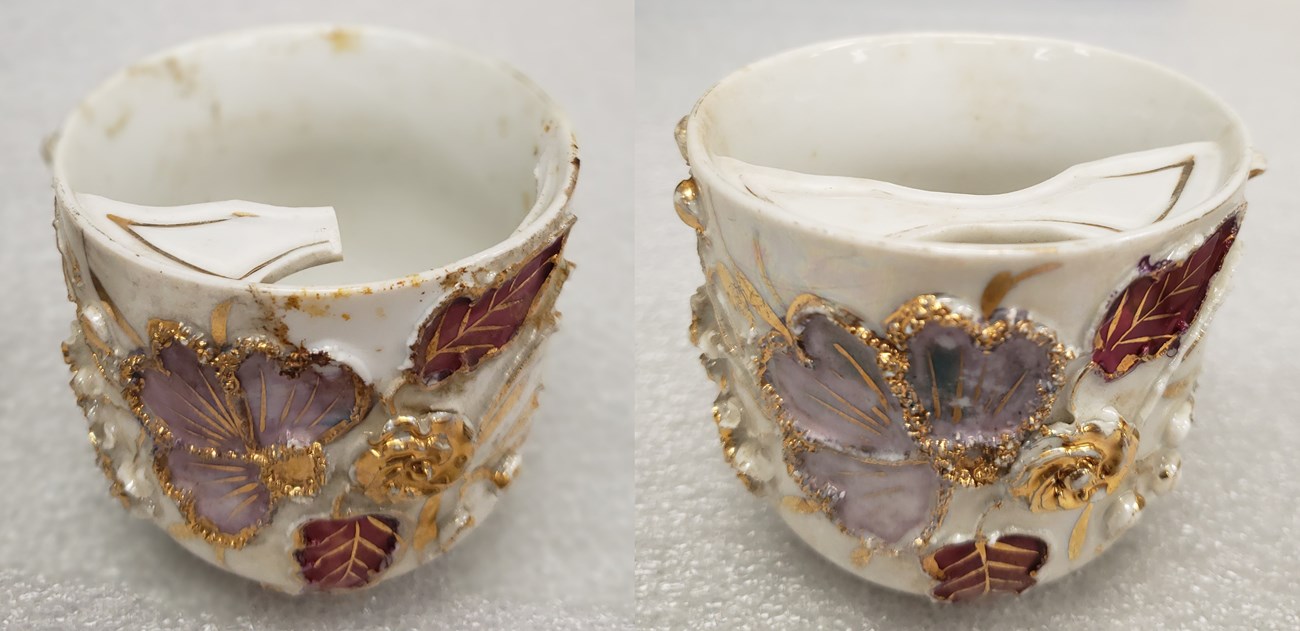Part of a series of articles titled Curious Collections of Fort Stanwix, The 19th & 20th Centuries.
Previous: Children's Toys
Next: Gothic Pickle Bottle
Article

National Park Service
Among the oddities found in the museum collection at Fort Stanwix National Monument are items FOST 11122 and FOST 5865. These items are mustache cup that date to the mid to late 1800s during the Victorian Era.
The single item labeled FOST 5865 was excavated in 1972 and found in a 19th Century privy located near where the main gate of the fort once sat. It is made of ironstone and can be dated to circa 1870 – 1910. The entire guard has broken off but looks like it was once trimmed along the edges with gold paint. This too, is a right-handed cup.
The items labeled FOST 11122 were excavated in 1974, from a former privy pit on park grounds. They are a matched pair made of ironstone with gold and pink floral highlights. One is missing half of its “mustache guard” and both are missing their handles and the nubs on the right side of the guard indicate they were right-handed cups. Left-hand style cups were also known to exist.
From Clean Shaven to Trendy
After years of clean-shaven faces being in-style, the wearing of facial hair became peak fashion in the 19th Century. When the British colonial powers spread into India, mustaches were the dominant style. Soon military men began imitating them and eventually, new military regulations were written to allow them (as long as the rest of the face was shaved). This novel fashion spread through the ranks of the military, Great Britain, the European continent, then North America.
Men’s Fashion Considerations
In the 1860 Gentlemen’s Book of Etiquette and Manual of Politeness, Cecil B Hartley warned that mustaches must be kept “within limits” and “never be curled, nor pulled out to an absurd length. Still worse is it to cut them close with the scissors. The mustache should be neat and not too large.”It seems many men had strong opinions on how mustaches should be worn. Popular authors of the time, like Rudyard Kipling, Guy de Maupassant, and Sir Arthur Conan Doyle were known to comment on the proper style, trim, and even shape of mustaches. Some, like Mark Twain, even rallied against beards in favor of the stache, stating that a beard “performs no useful function; it is a nuisance and a discomfort; all nations hate it; all nations persecute it with the razor.”
Wax as a result, became the popular method to tame one’s lip hairs. Combed and coated or twisted into handlebars, a neatly waxed mustache kept in shape the whole day. Wax prevented crumbs tangled throughout your lip hair and stopped your stache from drooping. It even made it less unruly when smooching a paramour!
But, a well waxed stache seeminly had only one downfall: hot tea. This ubiquitous drink that became synonymous with the British Empire could melt the wax right out of one’s stache, leaving it loose, unkempt, and dirty.

Odd Solutions for Odd Problems
In this instance, necessity became the father of invention. Within a decade of the military regulation change, British potter Harvey Adams saw the potential to make a profit and serve a need of the masses, however superficial it may have seemed. The money-making twist on a teacup was a small stache-shaped shield that kept the hairs in question from being dunked in the hot drink. This patented invention was so popular that within 15 years, he was able to retire!
His invention and his business were noted by author Llewellyn Frederick William Jewitt, in 1878’s The Ceramic Art of Great Britain in the following statement: “In tea and breakfast services many novel, but at the same time chastely beautiful designs, have been introduced by this firm, who have also the credit of being the first to make and introduce “moustache cups”—an invention that has become so popular as to be adopted by many other firms.”

National Park Service
Rise & Fall of Use
Although Adams is widely credited with being the inventor of this manly sippy cup, other claims have crept up in England, Canada, and even Texas! Mustache cups were made from earthenware, porcelain, stoneware, tin and silver plates and came in many shapes and sizes, ranging from tiny demitasse cups to large farmer’s cups holding up to a quart of liquid. Potters created mustache cups which featured landscapes, hunting scenes, animals and birds, flowers, and interesting geometric designs. Portrait mustache cups were rare and highly desirable. Many mustache cups, especially those made in Germany, had luster grounds, which were Victorian favorites.
Although the decorations might seem very “feminine” for the time, this is mostly because women were expected to purchase and manage the household chinaware. By the early 1900s, popular chain stores like Sears Roebuck, Macy’s and Woolsworth all carried and sold versions of them.
With the coming of World War I in the 1910s, clean shaven face on military men were once again preferred. Mostly because soldiers had to ensure a tight seal on gas masks worn on the frontline trenches. With this dark stroke, the mustache cup fell to the side a frivolous marker of a less dark time.
Hanson, Lee and Dick Ping Hsu. 1975. Casemates and Cannonballs: Archeological Investigations at Fort Stanwix, Rome, New York. Publications in Archeology, No. 14. Department of the Interior: Washington, D.C.
Part of a series of articles titled Curious Collections of Fort Stanwix, The 19th & 20th Centuries.
Previous: Children's Toys
Next: Gothic Pickle Bottle
Last updated: July 28, 2025